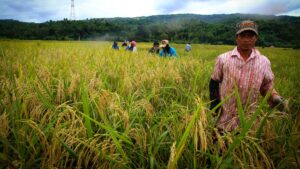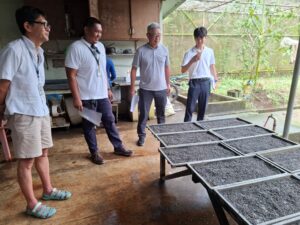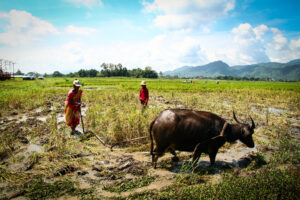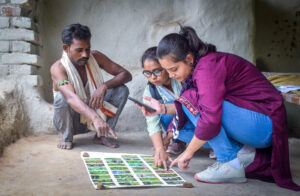by Muhammad Ashraful Habib*, Swati Nayak*, Nuruzzaman*, and Saidul Islam*
Lying in the southeastern part of Bangladesh, the Chattogram Hill Tracts (CHT) are the country’s only extensive hilly region that belongs to a low-productive agriculture zone. Most rural households in this region depend on agriculture-related activities for their livelihoods, yet some inhabitants have never, or only rarely, received information on new rice varieties. The rough terrain, with limited plains and steep slopes, further makes it difficult for the farmers to cultivate crops, especially rice. IRRI is assisting these farmers to cope with several of the challenges in sustaining their productivity and economic stability.
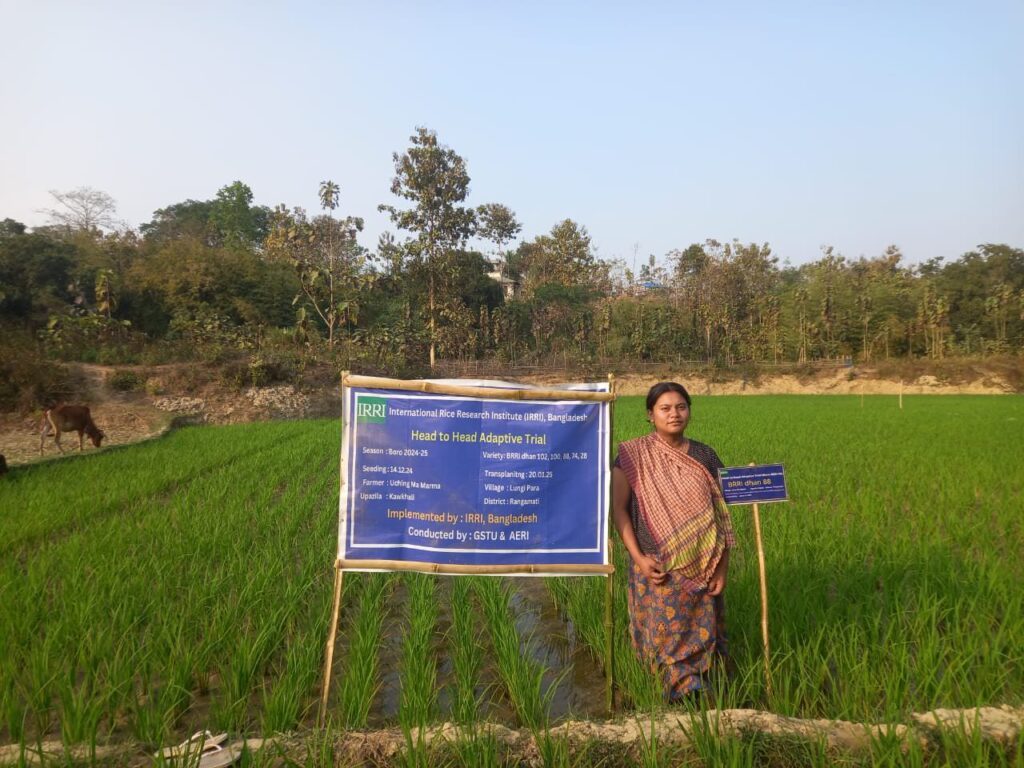
The Search for Best-Fitted Varieties and Performance Evaluation
IRRI and the Bangladesh Rice Research Institute (BRRI) initiated a series of farmer led Head-to-Head Adaptive Trials (HHATs) to identify high-yielding, short-duration rice varieties capable of withdstanding the region’s specific challenges, such as water scarcity and poor soil fertility. The market segment for best-fit rice varieties of the hilly ecosystem is TLaMF-I (Transplanted, late duration, medium slender-irrigated). The On-Farm Trial was conducted in Khagrachari and Rangamati districts using various varietal entries like BRRI dhan28, BRRI dhan74, BRRI dhan84, BRRI dhan88 and BRRI dhan100.
BRRI dhan74 was used as the the benchmark, while BRRI dhan28 was recognized by farmers as the local check variety. The remaining varieties, BRRI dhan84, BRRI dhan88, and BRRI dhan100, were evaluated as test varieties. The results showed that BRRI dhan100 and BRRI dhan88 produced the highest genetic yield, reaching 7.16 t/ha and 6.42 t/ha,respectively, in Khagrachari. On the other hand, BRRI dhan100 and BRRI dhan88 produced 6.20 t/ha and 6.80 t/ha,respectively, in Rangamati.
BRRI dhan88 is a Boro season rice variety released by the Bangladesh Rice Research Institute (BRRI) in 2018. This medium slender rice variety, with an average lifespan of 140-143 days, is tolerant to Bacterial Leaf Blight, Neck Blast, Leaf Blast, and Lodging. The crop grows to a height of 96cm with an average yield of 7t/ha. In the OFT of the TLaMF-I market segment in Boro 2023-24, BRRI dhan88 yielded 17.46% higher than local variety BRRI dhan28 (Boro 2022-23) and 3.17% more than the benchmark variety BRRI dhan74 (Boro 2022-23).
BRRI dhan100, a Boro season rice variety released by BRRI in 2021, has a medium slender grain, a lifespan of 148 days, and key traits such as zinc enrichment, lodging tolerance, and moderate resistance to bacterial leaf blight, sheath blight, and whitehead. With an average genetic yield of 7.7 t/ha and a plant height of 101 cm, BRRI dhan100 outperformed BRRI dhan28 (Boro 2022-23) by 24.64% and the benchmark BRRI dhan74 by 5.80% in the Boro 2023-24 season.
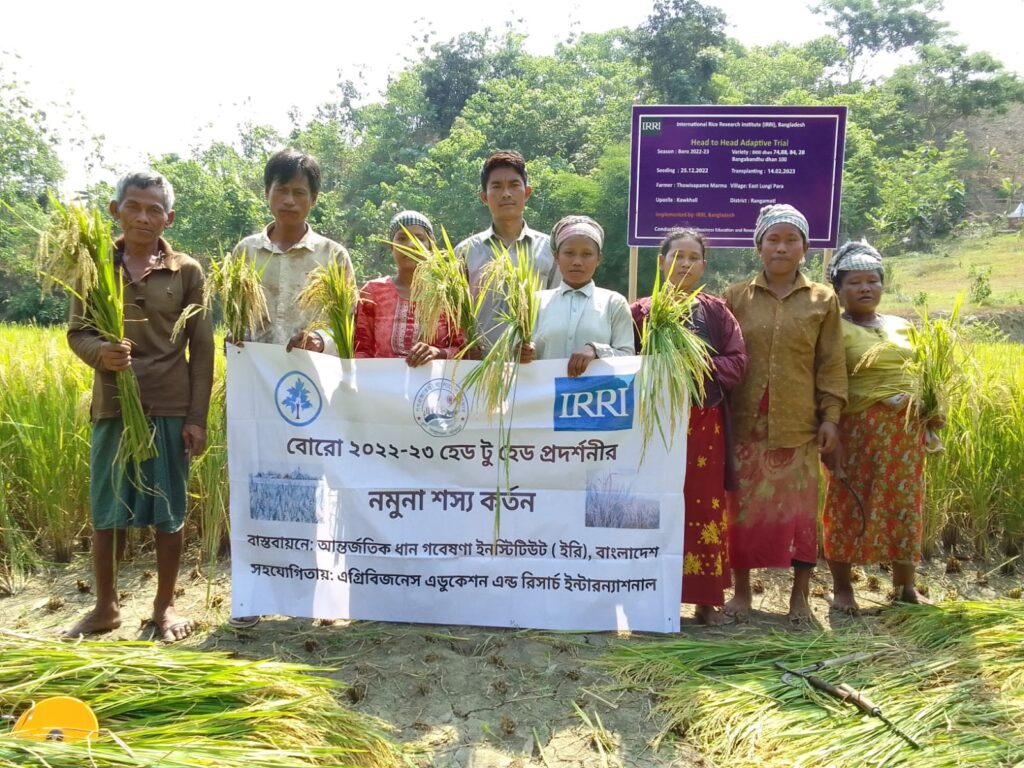
A new dawn in the face of challenging terrain
BRRI dhan88 and BRRI dhan100 varieties are changing the lives of farmers in Khagrachari and Rangamati by addressing agricultural challenges such as erratic rainfall, limited irrigation, reduced soil fertility, etc. These high-yielding and stress-tolerant rice varieties have improved productivity, food security and incomes. With traits like drought tolerance, superior grain quality, and higher yields, BRRI dhan88 and BRRI dhan100 have empowered farmers by reducing crop losses, lowering production costs, and enhancing agricultural sustainability.
Uchimong Marma, a smallholder in Khagrachari, struggled for years due to lack of quality seeds and irrigation. In 2022, he learned about the On-Farm Trials (OFT) under IRRI’s supervision, cultivating BRRI dhan88, BRRI dhan100, BRRI dhan84, BRRI dhan74 (as the benchmark), and BRRI dhan28 (as the local variety). His yields were 6.48 tons/ha, 7.04 tons/ha, 5.98 tons/ha, 6.40 tons/hectare, and 4.35 tons/hectare, respectively. Despite water scarcity, these varieties nearly doubled yields compared to traditional varieties. Inspired by these results, Uchimong adopted BRRI dhan88 and BRRI dhan100 and encouraged neighboring farmers to do the same.
Aungsingh Chakma, a farmer from Rangamati, was on the verge of quitting rice farming due to inconsistent rainfall, and a worsening water crisis. The lack of high-quality, climate-resilient seeds further worsened his losses. In 2022, he participated in the OFT under IRRI’s supervision, cultivating BRRI dhan88, BRRI dhan100, BRRI dhan84, BRRI dhan74 (benchmark), and BRRI dhan28 (local variety), which resulted in yields of 6.52 tons/ha, 7.10 tons/ha, 6.05 tons/ha, 6.38 tons/ha, and 4.42 tons/ha, respectively. The results clearly demonstrated the superiority of BRRI dhan88 and BRRI dhan100, which yielded almost double compared to traditional varieties. Seeing their potential in water-limited conditions, Aungsingh expanded the cultivation of these varieties in his community. Over time, he emerged as an informal supplier of improved rice varieties, promoting agricultural sustainability and food security in Rangamati.
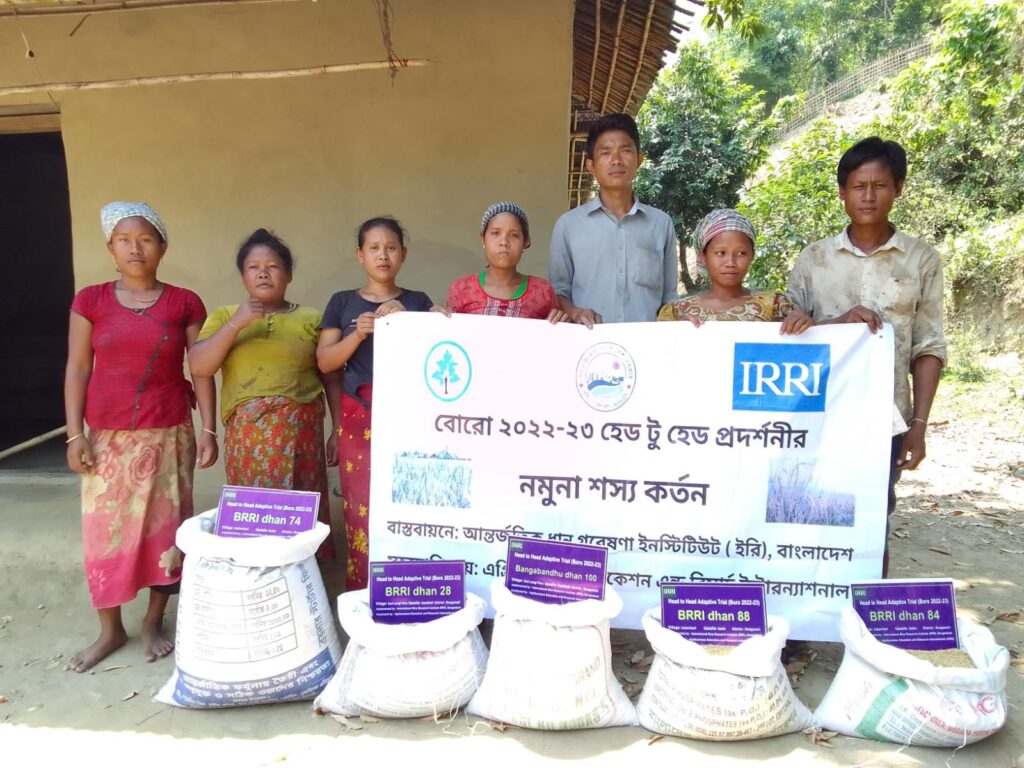
Women farmers leading the change
Shoikliching Marma a member of the Kawkhali Women Seed Producer Group of Lungi Para village in Rangamati district and Engki Chakma, a member of Vuachari Women Seed Producer Group of Khagrachari Sadar Upazila, found a new hope when their seed production group began cultivating BRRI dhan88 and BRRI dhan100 varieties Despite their interest in modern rice cultivation, they struggled to find varieties suited for hilly terrain and limited irrigation. When IRRI distributed seeds for experimental yield trials through OFT, they cultivated BRRI dhan88, BRRI dhan84, BRRI dhan74 (benchmark), and BRRI dhan28 (local variety).
These two women farmers yielded 6.54 ton/ha and 6.38 ton/ha from BRRI dhan88, while BRRI dhan100 yielded 7.0 ton/ha and 7.12 ton/ha . Expressing her happiness, Shoikliching said, “We never got such a large amount of rice yield in our region before by cultivating any other variety of rice. BRRI dhan88 and BRRI dhan100 varieties of rice will heal the sorrow of the farmers of our region for years to come”
A brighter future for the marginal smallholders
With the help of the various seed stakeholders, IRRI continues to promote farmer-to-farmer seed exchange, awareness campaigns, women’s empowerment, value chain development, and climate-resilient agriculture policies. These participatory engagements are accelerating the scaling of BRRI dhan88 and BRRI dhan100 in the hilly regions of Bangladesh, which help improve food security, increase farmer incomes, and promote sustainable agricultural development.
Backed by One CGIAR’s initiative and IRRI’s core One Rice Breeding strategy, these efforts ensure the delivery of improved rice varieties to end users more effectively. Such impact stories reflect what our farmers need and how agricultural innovation in these unique highlands can drive transformative change, paving the way for a more resilient and sustainable future for Bangladesh’s agriculture.
About the Authors:
*International Rice Research Institute

